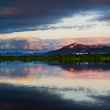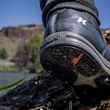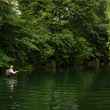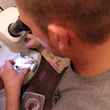I was talking to the editor of a fly fishing magazine the other day, and he mentioned that he was going to do a story on a fellow who had an awfully large fly collection. The exact number didn’t stick in my head, but it seems to me that it was somewhere along the lines of 73,000 flies. Good Lord, assuming that you could only fish a couple at a time, where would you ever start?
Fly selection is, admittedly, an inexact science. About the only way that you’ll ever know you’ve made the right decision is to tie one on and cast away. Of course you still have to worry about your presentation - your fly better act like the real thing if you want it to be successful - but assuming that your technique is more or less on the money, the best feedback you’ll ever get will be from the fish that grabs, or doesn’t, your fly of the moment.
So where do you begin? My first suggestion would be to take the time to look, to really look, at the water. What do you see? Are there visible signs of fish feeding? If so, you’ve got a great place to start. Most flies fall into one of two general categories; imitations and attractors. If you notice fish keying on something specific, then an imitation of that particular critter would be an excellent choice.
I drove down to the Yellowstone river prior to spring run-off a few years back and the first thing I noticed was that there were dozens of trout rising upstream of the bridge where I’d parked. At first glance those fish appeared to be eating the plentiful Black Quills (also known as Western March Browns), a handsome, relatively large mayfly that’s common here in Montana in April and May.
I’ve never done all that well on Black Quills, though; mostly because trout don’t seem to key on the dun (recently emerged) stage of the insect. Consequently, I spent a few minutes staring at the water and sure enough those rainbows and cutthroats were taking size 18 Blue Winged Olives, a smaller, less visible mayfly that was hatching at the same time and in the same area as the Black Quills. It was a classic example of what we call a “masking hatch,”a situation where the trout were feeding selectively on a smaller fly while they ignored what seemed, at least from a fly fisher’s perspective, to be a larger and more alluring meal.
To make a long story short, I tied on a little Sparkle Dun to imitate those Blue Winged Olives and started catching fish immediately. Luck? Not really. My success was due to the fact that I’d taken a couple of minutes to observe the situation and then picked my fly accordingly.
In general, when you’re selecting an imitation you’ll want to pay particular attention to the following factors:
Size
Try a fly that’s roughly the same size as the natural, whether it’s an insect, a minnow or anything else that you’re trying to copy.
Movement
If the fish are eating something specific, you’ll want to fish an imitation you can manipulate on (or in) the water to mimic the food source.
Shape
Choose a fly that matches the outline you’re hoping to simulate.
Color
Likewise, duplicate the color as closely as possible.
Now when the fish aren’t actively feeding, or when you suspect that they’re feeding on something you can’t see, you might want to fish an attractor pattern instead of an imitation. Attractors don’t usually mimic any one specific food source. Rather, they suggest something tasty and vulnerable.
The Woolly Bugger is a great example. It’s tied with a marabou tail and a chenille body, while a soft, webby saddle hackle is palmered the entire length of the hook shank. The end result is that the fly moves seductively through the water. Depending on its size and coloration, it could be taken for a leech, an aquatic worm, an injured baitfish, a hellgrammite, a stonefly nymph, a cranefly larva, a crayfish, or even a sculpin. In other words, it looks like something good to eat without being pigeonholed into one specific niche.
The Royal Wulff would be another good example. It represents a mayfly floating on the surface, but Lord, what a mayfly! With split, upright, white calf tail wings, a peacock herl body divided by a segment of red floss, a moose hair tail, and enough hackle to float three flies, it’s more a caricature than an imitation. And that’s exactly the point. Attractors usually exaggerate one or two of the four elements I just mentioned in order to grab and hold the fish’s attention. You’re not trying to convince the fish that your fly is a size 14 Hendrickson. You’re trying to convince him it’s something worth eating.
In the end, there are only four hard and fast rules for choosing a fly. First, take the time to really look at the water. Second, if you see feeding fish, tie on an imitation that mimics the most likely food source. Third, if you don’t see any feeding activity, try an attractor that suggests an insect or baitfish common to the area. Lastly, and this is an especially important point, pick a fly that inspires your confidence. You’ll fish it with more focus and intensity, which almost always translates into better luck at the end of the day.
Of course there are always going to be times when a fly that should work doesn’t, or when you can see fish feeding but you’ll be damned if you can figure out what they’re eating. Which is no big deal. If you caught every fish in your immediate vicinity, you’d be bored out of your mind in an hour or two. So my advice, for whatever it’s worth, is to enjoy the ones you catch, don’t worry about the ones you don’t, and keep in mind something Jim Harrison once wrote:
“I stare into the deepest pool of the river which holds the mystery of a cellar to a child, and think of those two track roads that dwindle into nothing in the forest. I have this feeling of walking around for days with the wind knocked out of me.”
We are blessed to be fly fishermen. Few things even come close.































Comments
Hexmeister replied on Permalink
Take it to the bank. I'd add only one thing: When in doubt, a Parachute Adams is never a bad choice!
Michael G Vaughn replied on Permalink
I have a ritual I go through. Park the car. Walk over and look at the stream from a distance. Back at the car, pour 1/4 cup of coffee to sip. Slowly get into waders and boots as I contemplate what I saw from a distance in the stream. Sip coffee. Walk down to stream's edge with coffee cup, looking for insects on surface, or turning rocks to see what is there. Back to car, mount reel to rod, thread line through guides. Consider what I found at stream's edge. Depending on mood, rig leader setup for dry or nymph. Finally, tie on either a Stimulator or Peeping Caddis and go catch some fish. Works every time!
Lou Cragin replied on Permalink
Good article with a couple omissions. If nothing is rising consider kicking I’ve rocks and see what’s moving around. Secondly, don’t forget a seine of some sort. Seine the water at several depths to see what is swimming by subsurface. Both techniques will improve your catching.
Pages